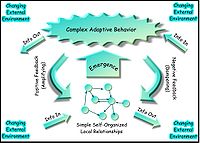
Photo from wikipedia
Network medicine provides network theoretical tools, methods and properties to study underlying laws governing human interactome to identify disease states and disease complexity leading to drug discovery. Within this framework,… Click to show full abstract
Network medicine provides network theoretical tools, methods and properties to study underlying laws governing human interactome to identify disease states and disease complexity leading to drug discovery. Within this framework, we investigated the topological properties of ovarian cancer network (OCN) and the roles of hubs to understand OCN organization to address disease states and complexity. The OCN constructed from the experimentally verified genes exhibits fractal nature in the topological properties with deeply rooted functional communities indicating self-organizing behavior. The network properties at all levels of organization obey one parameter scaling law which lacks centrality lethality rule. We showed that $\langle k\rangle $ can be taken as a scaling parameter, where, power law exponent can be estimated from the ratio of network diameters. The betweenness centrality $C_B$ shows two distinct behaviors one shown by high degree hubs and the other by segregated low degree nodes. The $C_B$ power law exponent is found to connect the exponents of distributions of high and low degree nodes. OCN showed the absence of rich-club formation which leads to the missing of a number of attractors in the network causing formation of weakly tied diverse functional modules to keep optimal network efficiency. In OCN, provincial and connector hubs, which includes identified key regulators, take major responsibility to keep the OCN integrity and organization. Further, most of the key regulators are found to be over expressed and positively correlated with immune infiltrates. Finally, few potential drugs are identified related to the key regulators.
Journal Title: Briefings in bioinformatics
Year Published: 2022
Link to full text (if available)
Share on Social Media: Sign Up to like & get
recommendations!